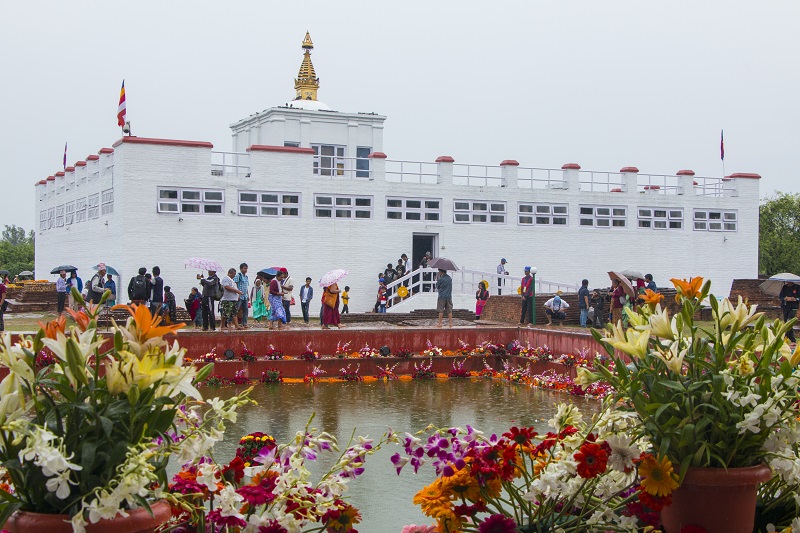

The master plan for the development of the birthplace of Buddha is almost complete. This master plan initially prepared by the famous Japanese architect Prof Kenzo Tange (1913 -2005) is concluding nearly 40.
It took six years for Tange to draw up the Lumbini Master Plan. Although the goal was to implement it within 15 years in two phases, the work as per the master plan has not been completed even now due to negligence of the government. It is almost certain that Lumbini will be one of the few places in Nepal worth visiting once the master plan is implemented fully albeit late.
Basanta Maharjan, a researcher in Buddhism, holds the view that Lumbini being developed as an international tourism site and the operation of the Gautam Buddha International Airport some 20 km away indicates a bright future for this area. “Had the Lumbini Master Plan been executed within the specified time, tourism in the area would have increased by leaps and bounds. But although late, it is in completion phase, and this is a happy development,” Maharjan says.
He suggests linking the Buddhist sites of Nepal and India and promoting tourism in Lumbini for greater reaping economic benefits. Although hundreds of thousands of Buddhist tourists in Lumbini visit the place using the itinerary of touring this holy place of Buddhism as per the Buddhist culture, they stay here only for less than three days.
As per the itinerary suggested by the master plan, on the first day the pilgrims spend the night in the Lumbini Village area, and mentally and physically prepare for the spiritual zone. On the second day, they purify their mind in the Cultural Zone and it’s only on the third day that they visit the Mayadevi temple for paying homage.
The visitors are then expected to spend some more time visiting the Lumbini area which is spread over 1,155 bighas. It’s for this reason that the Lumbini Development Trust, the body responsible for the development of the Lumbini area, came up with the idea of simultaneously developing sites related to the life of the Buddha that lie in nearby Kapilbastu and Nawalparasi (Bardaghat Susta East and West).
Culture expert Dr. Gitu Giri sees the need to develop these sites in Kapilbastu and Nawalparasi as well and at par with Lumbini for making their pilgrimage a complete one and lengthening the stay of visitors. “The LDT is confined only to Lumbini and due to this, the other sites related to the life of the Buddha are in the shadow. Until these sites are linked to Lumbini and developed simultaneously with it, Lumbini’s tourism will not be promoted,” she opines.
Dr. Giri stresses the need to develop these sites by conserving and promoting them so that the living standard of local people is also improved through the promotion of tourism in Lumbini. The government should work with commitment and civil society and the private sector should join hands to achieve this goal, she suggests.
Experts on tourism and culture have suggested Nepal can reap the economic benefits from tourism in Lumbini only if other places like Tilaurakot, Gotihawa, Niglihawa, Kudan, Sagarhawa, Araurakot, Devdaha, and Ramgram related to the life of the Buddha are connected to Lumbini and developed on an equal footing.
Lumbini is the place where Siddhartha Gautam was born. It is a sacred, historic, archaeologically significant, and religious heritage site enlisted in the list of UNESCO World Heritage Sites. Several Buddhist literatures have indicated that Queen Mayadevi, the wife of King Sudhdhodan, gave birth to Siddhartha Gautam in Lumbini, a forested area, in 623 BC. In time, this forested area saw different human activities. A stone pillar installed by the Maurya dynasty emperor Ashoka in 249 BC refers to Lumbini as ‘Lummini Gam’. This word is also mentioned in various texts of the Buddhist scripture the ‘Tripitaka’.
There are more than 24 Viharas and monasteries in the Lumbini area at present. Lumbini was enlisted as a World Heritage Site in 1997. There are ancient articles and relics dating back to 1100 century BC. The Mayadevi Temple is the center of Lumbini. Followers of Buddhism always wish to visit the birthplace of the Buddha at least once in their lifetime. Around 1.6 million visitors from around the world visit Lumbini annually.
Tilaurakot Tilaurakot is another place related to the life of the Buddha. It lies about 28 km west of Lumbini where Siddhartha Gautam spent 29 years of his life. Preparations are on to have Tilaurakot on the list of World Heritage Sites. LDT is organizing the ‘Tilaurakot Summit’ on May 17 and 18 for that same purpose.
Experts from Nepal and various countries will be participating in this conference. The Department of Archaeology had, with the support of the Durham University of the UK, the federal government, and archeologists, carried out archaeological excavations in Tilaurakot from time to time to collect the required evidence for enlisting the place in the World Heritage Sites list, officiating senior archaeology officer at the Department, Himal Uprety, said. According to him, the required evidence have been collected. Even though an important place, most visitors coming to Lumbini are not found visiting this holy place. There is no adequate tourist infrastructure here.
There is the remnant of the Tilaurakot palace here. Visitors to Tilaurakot return after observing the western and eastern gates to the ancient town and the remnants of the palace which is in the center. There is the Dhamanihawa Stupa some 700 m away from the ancient palace. This is the mausoleum of King Sudhdhodan and Mayadevi, Siddhartha Gautam’s father and mother respectively.